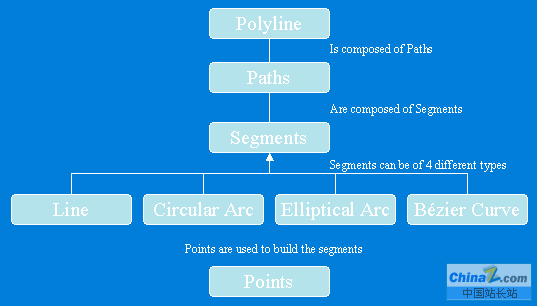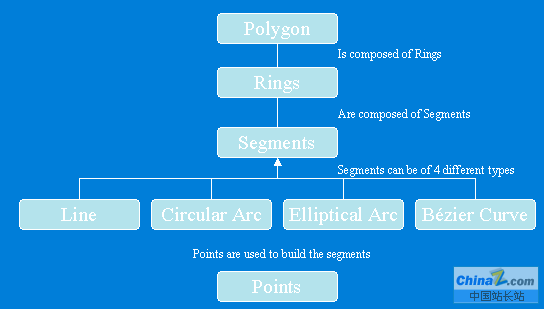Geometry 對(duì)象淺析_.Net教程
推薦:再議ASP.NET DataGrid控件中的“添加新行”功能 說(shuō)起在DataGrid中添加新行,ASP.NET開發(fā)的大牛人物:Dino Esposito,他的《構(gòu)建WEB解決方案--應(yīng)用ASP.NET和ADO.NET》一書中提供了和以上兩位類似的方法,但是Dino又加了些功能,首先就是&rd
ArcEngine Geometry庫(kù)定義了基本幾何圖形的矢量表達(dá)形式,頂級(jí)的幾何圖形有Points、Multipoints、Polylines、Polygons、 Multipatches,Geodatabase和繪圖系統(tǒng)使用這些幾何圖形來(lái)定義其他各種形狀的特征和圖形,提供了編輯圖形的操作方法和地圖符號(hào)系統(tǒng)符號(hào)化特征數(shù)據(jù)的途徑。
Geometry庫(kù)中幾個(gè)核心類和接口構(gòu)成了Geometry對(duì)象的基本框架。
GeometryEnvironment
GeometryEnvironment提供了從不同的輸入、設(shè)置或獲取全局變量來(lái)創(chuàng)建幾何圖形的方法,以便控制geometry方法的行為。GeometryEnvironment對(duì)象是一個(gè)單例對(duì)象。
以下為引用的內(nèi)容: public IPolyline TestGeometryEnvironment() public IPolyline TestGeometryEnvironment()   { { ISpatialReferenceFactory spatialReferenceFactory = new SpatialReferenceEnvironmentClass(); ISpatialReferenceFactory spatialReferenceFactory = new SpatialReferenceEnvironmentClass();  //Create a projected coordinate system and define its domain, resolution, and x,y tolerance. //Create a projected coordinate system and define its domain, resolution, and x,y tolerance. ISpatialReferenceResolution spatialReferenceResolution = spatialReferenceFactory.CreateProjectedCoordinateSystem((int)esriSRProjCSType.esriSRProjCS_NAD1983UTM_11N) as ISpatialReferenceResolution; ISpatialReferenceResolution spatialReferenceResolution = spatialReferenceFactory.CreateProjectedCoordinateSystem((int)esriSRProjCSType.esriSRProjCS_NAD1983UTM_11N) as ISpatialReferenceResolution; spatialReferenceResolution.ConstructFromHorizon(); spatialReferenceResolution.ConstructFromHorizon(); ISpatialReferenceTolerance spatialReferenceTolerance = spatialReferenceResolution as ISpatialReferenceTolerance; ISpatialReferenceTolerance spatialReferenceTolerance = spatialReferenceResolution as ISpatialReferenceTolerance; spatialReferenceTolerance.SetDefaultXYTolerance(); spatialReferenceTolerance.SetDefaultXYTolerance(); ISpatialReference spatialReference = spatialReferenceResolution as ISpatialReference; ISpatialReference spatialReference = spatialReferenceResolution as ISpatialReference;  //Create an array of WKSPoint structures starting in the middle of the x,y domain of the //Create an array of WKSPoint structures starting in the middle of the x,y domain of the  //projected coordinate system. //projected coordinate system.  double xMin; double xMin; double xMax; double xMax; double yMin; double yMin; double yMax; double yMax; spatialReference.GetDomain(out xMin, out xMax, out yMin, out yMax); spatialReference.GetDomain(out xMin, out xMax, out yMin, out yMax);  double xFactor = (xMin xMax) * 0.5; double xFactor = (xMin xMax) * 0.5; double yFactor = (yMin yMax) * 0.5; double yFactor = (yMin yMax) * 0.5;  WKSPoint[] wksPoints = new WKSPoint[10]; WKSPoint[] wksPoints = new WKSPoint[10]; for (int i = 0; i < wksPoints.Length; i ) for (int i = 0; i < wksPoints.Length; i )   { { wksPoints[i].X = xFactor i; wksPoints[i].X = xFactor i; wksPoints[i].Y = yFactor i; wksPoints[i].Y = yFactor i; } }  IPointCollection4 pointCollection = new PolylineClass(); IPointCollection4 pointCollection = new PolylineClass();  IGeometryBridge2 geometryBridge = new GeometryEnvironmentClass(); IGeometryBridge2 geometryBridge = new GeometryEnvironmentClass(); geometryBridge.AddWKSPoints(pointCollection, ref wksPoints); geometryBridge.AddWKSPoints(pointCollection, ref wksPoints);  IPolyline polyline = pointCollection as IPolyline; IPolyline polyline = pointCollection as IPolyline; polyline.SpatialReference = spatialReference; polyline.SpatialReference = spatialReference;  return polyline; return polyline; } } |
new GeometryEnvironmentClass僅僅是創(chuàng)建了一個(gè)指向已存在的GeometryEnvironmentClass的引用。注意 IGeometryBridge2接口的使用,addWKSPoints方法將WKSPoint二維點(diǎn)添加到PointCollection中,用于構(gòu)建 path、ring、polyline、polygon,或增加新點(diǎn)到Multipoint、TriangleFan、TriangleStrip。在 Geometry庫(kù)中,除了IGeometryBridge2還有IGeometryBridge接口,后者繼承了前者,增加了一些編輯功能(添加點(diǎn)、插入點(diǎn)、重置點(diǎn)、分段等)。
GeometryBag
GeometryBag是支持IGeometry接口的幾何對(duì)象引用的集合,任何幾何對(duì)象都可以通過IGeometryCollection接口添加到 GeometryBag中,但是在使用拓?fù)洳僮鞯臅r(shí)候,需要注意不同類型的幾何類型可能會(huì)有相互不兼容的情況。在向GeometryBag中添加幾何對(duì)象的時(shí)候,GeometryBag對(duì)象需要指定空間參考,添加到其中的幾何對(duì)象均擁有和GeometryBag對(duì)象一樣的空間參考。
以下為引用的內(nèi)容: private IPolygon GeometryBag_Example(IFeatureClass featureClass) private IPolygon GeometryBag_Example(IFeatureClass featureClass)   { {  //Check input objects. //Check input objects. if (featureClass == null) if (featureClass == null)   { { return null; return null; } }  IGeoDataset geoDataset = featureClass as IGeoDataset; IGeoDataset geoDataset = featureClass as IGeoDataset; ISpatialFilter queryFilter = new SpatialFilterClass(); ISpatialFilter queryFilter = new SpatialFilterClass();  //Set the properties of the spatial filter here. //Set the properties of the spatial filter here. IGeometry geometryBag = new GeometryBagClass(); IGeometry geometryBag = new GeometryBagClass();  //Define the spatial reference of the bag before adding geometries to it. //Define the spatial reference of the bag before adding geometries to it. geometryBag.SpatialReference = geoDataset.SpatialReference; geometryBag.SpatialReference = geoDataset.SpatialReference;  //Use a nonrecycling cursor so each returned geometry is a separate object. //Use a nonrecycling cursor so each returned geometry is a separate object.  IFeatureCursor featureCursor = featureClass.Search(queryFilter, false); IFeatureCursor featureCursor = featureClass.Search(queryFilter, false);  IGeometryCollection geometryCollection = geometryBag as IGeometryCollection; IGeometryCollection geometryCollection = geometryBag as IGeometryCollection; IFeature currentFeature = featureCursor.NextFeature(); IFeature currentFeature = featureCursor.NextFeature();  while (currentFeature != null) while (currentFeature != null)   { { //Add a reference to this feature's geometry into the bag. //Add a reference to this feature's geometry into the bag. //You don't specify the before or after geometry (missing), //You don't specify the before or after geometry (missing), //so the currentFeature.Shape IGeometry is added to the end of the geometryCollection. //so the currentFeature.Shape IGeometry is added to the end of the geometryCollection. object missing = Type.Missing; object missing = Type.Missing; geometryCollection.AddGeometry(currentFeature.Shape, ref missing, ref missing); geometryCollection.AddGeometry(currentFeature.Shape, ref missing, ref missing);  currentFeature = featureCursor.NextFeature(); currentFeature = featureCursor.NextFeature(); } }  // Create the polygon that will be the union of the features returned from the search cursor. // Create the polygon that will be the union of the features returned from the search cursor. // The spatial reference of this feature does not need to be set ahead of time. The // The spatial reference of this feature does not need to be set ahead of time. The  // ConstructUnion method defines the constructed polygon's spatial reference to be the same as // ConstructUnion method defines the constructed polygon's spatial reference to be the same as  // the input geometry bag. // the input geometry bag. ITopologicalOperator unionedPolygon = new PolygonClass(); ITopologicalOperator unionedPolygon = new PolygonClass(); unionedPolygon.ConstructUnion(geometryBag as IEnumGeometry); unionedPolygon.ConstructUnion(geometryBag as IEnumGeometry);  return unionedPolygon as IPolygon; return unionedPolygon as IPolygon; } } |
Points
一個(gè)點(diǎn)包括X、Y坐標(biāo),同時(shí)可以增加M、Z值及ID屬性來(lái)擴(kuò)展點(diǎn)的功能。
Multipoints
點(diǎn)的集合,多點(diǎn)組成Multipoint幾何類型,使用multipoint對(duì)象實(shí)現(xiàn)了的IPointCollection接口可以訪問所有的點(diǎn)元素,這些點(diǎn)同樣可以擁有M、Z值及ID屬性來(lái)獲得更多的地理空間內(nèi)涵。
下面列舉一個(gè)例子,通過一個(gè)已知的polyline來(lái)定義一個(gè)新的multipart polyline。

以下為引用的內(nèi)容: public IPolyline ConstructMultiPartPolyline(IPolyline inputPolyline) public IPolyline ConstructMultiPartPolyline(IPolyline inputPolyline)   { { IGeometry outGeometry = new PolylineClass(); IGeometry outGeometry = new PolylineClass();  //Always associate new, top-level geometries with an appropriate spatial reference. //Always associate new, top-level geometries with an appropriate spatial reference. outGeometry.SpatialReference = inputPolyline.SpatialReference; outGeometry.SpatialReference = inputPolyline.SpatialReference;   IGeometryCollection geometryCollection = outGeometry as IGeometryCollection; IGeometryCollection geometryCollection = outGeometry as IGeometryCollection;  ISegmentCollection segmentCollection = inputPolyline as ISegmentCollection; ISegmentCollection segmentCollection = inputPolyline as ISegmentCollection;  //Iterate over existing polyline segments using a segment enumerator. //Iterate over existing polyline segments using a segment enumerator. IEnumSegment segments = segmentCollection.EnumSegments; IEnumSegment segments = segmentCollection.EnumSegments;  ISegment currentSegment; ISegment currentSegment; int partIndex = 0;; int partIndex = 0;; int segmentIndex = 0;; int segmentIndex = 0;;  segments.Next(out currentSegment,ref partIndex, ref segmentIndex); segments.Next(out currentSegment,ref partIndex, ref segmentIndex); while(currentSegment != null) while(currentSegment != null)   { { ILine normal = new LineClass(); ILine normal = new LineClass();  //Geometry methods with _Query_ in their name expect to modify existing geometries. //Geometry methods with _Query_ in their name expect to modify existing geometries.  //In this case, the QueryNormal method modifies an existing line //In this case, the QueryNormal method modifies an existing line //segment (normal) to be the normal vector to //segment (normal) to be the normal vector to  //currentSegment at the specified location along currentSegment. //currentSegment at the specified location along currentSegment. currentSegment.QueryNormal(esriSegmentExtension.esriNoExtension, 0.5, true, currentSegment.Length / 3, normal); currentSegment.QueryNormal(esriSegmentExtension.esriNoExtension, 0.5, true, currentSegment.Length / 3, normal);   //Since each normal vector is not connected to others, create a new path for each one. //Since each normal vector is not connected to others, create a new path for each one. ISegmentCollection newPath = new PathClass(); ISegmentCollection newPath = new PathClass(); object missing = Type.Missing; object missing = Type.Missing; newPath.AddSegment(normal as ISegment, ref missing, ref missing); newPath.AddSegment(normal as ISegment, ref missing, ref missing); //The spatial reference associated with geometryCollection will be assigned to all incoming paths and segments. //The spatial reference associated with geometryCollection will be assigned to all incoming paths and segments. geometryCollection.AddGeometry(newPath as IGeometry, ref missing, ref missing); geometryCollection.AddGeometry(newPath as IGeometry, ref missing, ref missing);  segments.Next(out currentSegment,ref partIndex, ref segmentIndex); segments.Next(out currentSegment,ref partIndex, ref segmentIndex); } } //The geometryCollection now contains the new, multipart polyline. //The geometryCollection now contains the new, multipart polyline. return geometryCollection as IPolyline; return geometryCollection as IPolyline; } } |
ISegment接口的QueryNormal方法用來(lái)在弧段上的某一點(diǎn)生成該弧段的法線,指定其長(zhǎng)度,這樣就生成了新的segment,并且多個(gè)path添加到geometryCollection中,以IPolyline的形式返回。
Polylines
Polylines是有序path組成的集合,可以擁有M、Z和ID屬性值。Polyline對(duì)象的IPointCollection接口包含了所有節(jié)點(diǎn)的復(fù)制,IGeometryCollection接口可以獲取polyline的paths,ISegmentCollection接口可以獲取 polyline的segments。
Polyline結(jié)構(gòu)圖

Polygons
Polygon是一系列rings組成的集合,可以擁有M、Z和ID屬性值。每一個(gè)ring由一個(gè)或多個(gè)segment組成,Polygon或ring對(duì)象的IPointCollection接口包含了所有節(jié)點(diǎn)的復(fù)制,IGeometryCollection接口可以獲取polygon的rings, ISegmentCollection接口可以獲取polygon的segments。
Polygon結(jié)構(gòu)圖

Multipatch
Multipatch用于描述3D面狀幾何類型,由一系列的矢量三角形構(gòu)成,如果其中的part是一個(gè)ring,那么它必須是封閉的,第一個(gè)節(jié)點(diǎn)和最后一個(gè)節(jié)點(diǎn)相同,另外每個(gè)part所包含節(jié)點(diǎn)的順序非常重要,Inner Rings在Outer Rings之后,代表單個(gè)表面patch的一系列rings必須由第一個(gè)ring開始。

在9.0以后的開發(fā)包中,使用IGeneralMultiPatchCreator創(chuàng)建新的Multipatch,IGeometryMaterial進(jìn)行材質(zhì)貼圖。
以下為引用的內(nèi)容: public IMultiPatch CreateMultipatch() public IMultiPatch CreateMultipatch()   { { //Prepare the geometry material list. //Prepare the geometry material list. IGeometryMaterial texture = new GeometryMaterialClass(); IGeometryMaterial texture = new GeometryMaterialClass(); texture.TextureImage = "C:\\Temp\\MyImage.bmp"; texture.TextureImage = "C:\\Temp\\MyImage.bmp";  IGeometryMaterialList materialList = new GeometryMaterialListClass(); IGeometryMaterialList materialList = new GeometryMaterialListClass(); materialList.AddMaterial(texture); materialList.AddMaterial(texture);  //Create the multipatch. //Create the multipatch. IGeneralMultiPatchCreator multiPatchCreator = new GeneralMultiPatchCreatorClass(); IGeneralMultiPatchCreator multiPatchCreator = new GeneralMultiPatchCreatorClass(); multiPatchCreator.Init(4, 1, false, false, false, 4, materialList); multiPatchCreator.Init(4, 1, false, false, false, 4, materialList);  //Set up part. //Set up part.  //Could also use a Ring or a TriangleFan. //Could also use a Ring or a TriangleFan. multiPatchCreator.SetPatchType(0, esriPatchType.esriPatchTypeTriangleStrip); multiPatchCreator.SetPatchType(0, esriPatchType.esriPatchTypeTriangleStrip); multiPatchCreator.SetMaterialIndex(0, 0); multiPatchCreator.SetMaterialIndex(0, 0); multiPatchCreator.SetPatchPointIndex(0, 0); multiPatchCreator.SetPatchPointIndex(0, 0); multiPatchCreator.SetPatchTexturePointIndex(0, 0); multiPatchCreator.SetPatchTexturePointIndex(0, 0);  //Set real-world points. //Set real-world points. WKSPointZ upperLeft = new WKSPointZ(); WKSPointZ upperLeft = new WKSPointZ(); WKSPointZ lowerLeft = new WKSPointZ(); WKSPointZ lowerLeft = new WKSPointZ(); WKSPointZ upperRight = new WKSPointZ(); WKSPointZ upperRight = new WKSPointZ(); WKSPointZ lowerRight = new WKSPointZ(); WKSPointZ lowerRight = new WKSPointZ();  upperLeft.X = 0; upperLeft.X = 0; upperLeft.Y = 0; upperLeft.Y = 0; upperLeft.Z = 0; upperLeft.Z = 0; upperRight.X = 300; upperRight.X = 300; upperRight.Y = 0; upperRight.Y = 0; upperRight.Z = 0; upperRight.Z = 0; lowerLeft.X = 0; lowerLeft.X = 0; lowerLeft.Y = 0; lowerLeft.Y = 0; lowerLeft.Z = -100; lowerLeft.Z = -100; lowerRight.X = 300; lowerRight.X = 300; lowerRight.Y = 1; lowerRight.Y = 1; lowerRight.Z = -100; lowerRight.Z = -100;  multiPatchCreator.SetWKSPointZ(0, ref upperRight); multiPatchCreator.SetWKSPointZ(0, ref upperRight); multiPatchCreator.SetWKSPointZ(1, ref lowerRight); multiPatchCreator.SetWKSPointZ(1, ref lowerRight); multiPatchCreator.SetWKSPointZ(2, ref upperLeft); multiPatchCreator.SetWKSPointZ(2, ref upperLeft); multiPatchCreator.SetWKSPointZ(3, ref lowerLeft); multiPatchCreator.SetWKSPointZ(3, ref lowerLeft);  //Set texture points. //Set texture points. //Set the texture coordinates for a panel. //Set the texture coordinates for a panel. WKSPoint textureUpperLeft = new WKSPoint(); WKSPoint textureUpperLeft = new WKSPoint(); WKSPoint textureLowerLeft = new WKSPoint(); WKSPoint textureLowerLeft = new WKSPoint(); WKSPoint textureUpperRight = new WKSPoint(); WKSPoint textureUpperRight = new WKSPoint(); WKSPoint textureLowerRight = new WKSPoint(); WKSPoint textureLowerRight = new WKSPoint();  textureUpperLeft.X = 0; textureUpperLeft.X = 0; textureUpperLeft.Y = 0; textureUpperLeft.Y = 0; textureUpperRight.X = 1; textureUpperRight.X = 1; textureUpperRight.Y = 0; textureUpperRight.Y = 0; textureLowerLeft.X = 0; textureLowerLeft.X = 0; textureLowerLeft.Y = 1; textureLowerLeft.Y = 1; textureLowerRight.X = 1; textureLowerRight.X = 1; textureLowerRight.Y = 1; textureLowerRight.Y = 1;  multiPatchCreator.SetTextureWKSPoint(0, ref textureUpperRight); multiPatchCreator.SetTextureWKSPoint(0, ref textureUpperRight); multiPatchCreator.SetTextureWKSPoint(1, ref textureLowerRight); multiPatchCreator.SetTextureWKSPoint(1, ref textureLowerRight); multiPatchCreator.SetTextureWKSPoint(2, ref textureUpperLeft); multiPatchCreator.SetTextureWKSPoint(2, ref textureUpperLeft); multiPatchCreator.SetTextureWKSPoint(3, ref textureLowerLeft); multiPatchCreator.SetTextureWKSPoint(3, ref textureLowerLeft); IMultiPatch multiPatch = multiPatchCreator.CreateMultiPatch() as IMultiPatch; IMultiPatch multiPatch = multiPatchCreator.CreateMultiPatch() as IMultiPatch;  return multiPatch; return multiPatch; } } |
分享:AJAX實(shí)現(xiàn)web頁(yè)面中級(jí)聯(lián)菜單的設(shè)計(jì) 看了大峽搞的級(jí)聯(lián)菜單,我也班門弄斧一把,嘿嘿,花了一點(diǎn)時(shí)間搞了個(gè)級(jí)聯(lián)菜單貼上來(lái)看看。本例中只要你選擇成員分類名稱就會(huì)自動(dòng)顯示成員名稱: 首先在eclipse中建一個(gè)項(xiàng)目,名稱你自
- asp.net如何得到GRIDVIEW中某行某列值的方法
- .net SMTP發(fā)送Email實(shí)例(可帶附件)
- js實(shí)現(xiàn)廣告漂浮效果的小例子
- asp.net Repeater 數(shù)據(jù)綁定的具體實(shí)現(xiàn)
- Asp.Net 無(wú)刷新文件上傳并顯示進(jìn)度條的實(shí)現(xiàn)方法及思路
- Asp.net獲取客戶端IP常見代碼存在的偽造IP問題探討
- VS2010 水晶報(bào)表的使用方法
- ASP.NET中操作SQL數(shù)據(jù)庫(kù)(連接字符串的配置及獲取)
- asp.net頁(yè)面?zhèn)髦禍y(cè)試實(shí)例代碼
- DataGridView - DataGridViewCheckBoxCell的使用介紹
- asp.net中javascript的引用(直接引入和間接引入)
- 三層+存儲(chǔ)過程實(shí)現(xiàn)分頁(yè)示例代碼
.Net教程Rss訂閱編程教程搜索
.Net教程推薦
- ASP.NET立即上手教程(14)
- 解讀VS2008中查看.NET源碼的設(shè)置方法
- 解析Asp.net動(dòng)態(tài)生成頁(yè)面控件的辦法
- 解析虛擬主機(jī)上用Asp.net實(shí)現(xiàn)Urlrewrite
- Asp.Net使用POST方法最簡(jiǎn)單的實(shí)現(xiàn)
- Asp.net FMS 開發(fā)視頻網(wǎng)站
- 解析DataList中HyperLink數(shù)據(jù)綁定及鏈接寫法
- 教你如何入門ASP.NET數(shù)據(jù)庫(kù)編程
- Asp.net中的mail的發(fā)送
- 解析.Net基礎(chǔ):C#中對(duì)DatagridView部分常用操作
- 相關(guān)鏈接:
- 教程說(shuō)明:
.Net教程-Geometry 對(duì)象淺析
 。
。